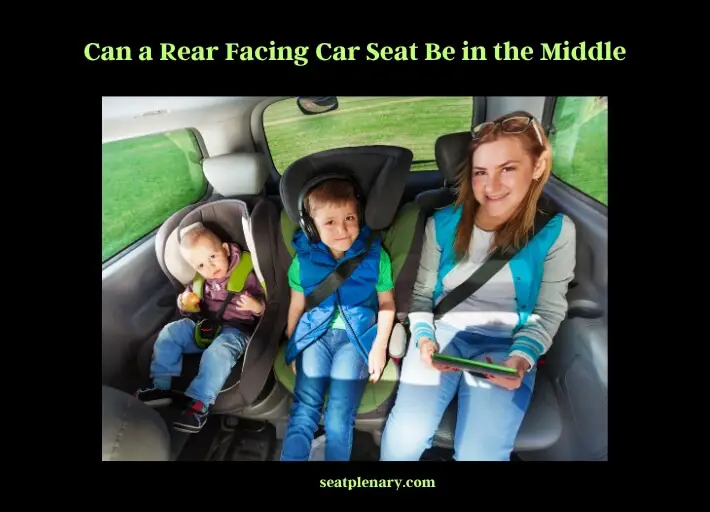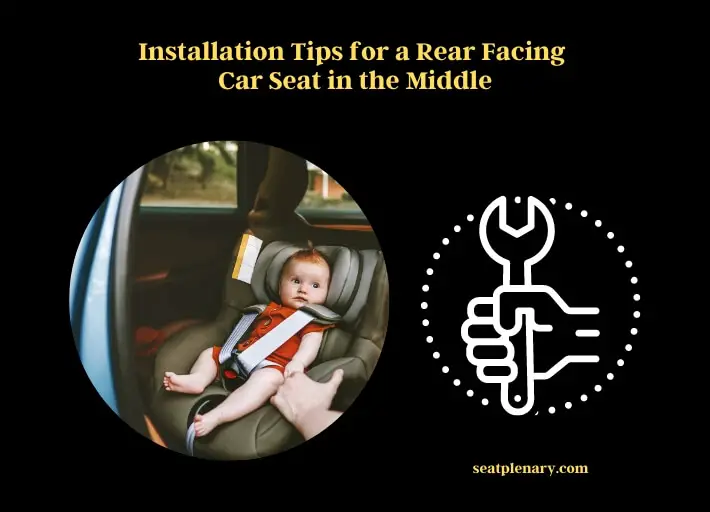A lot of us may wonder, can a rear facing car seat be in the middle? This might not be your regular water-cooler talk but if you are a parent, you know that it’s an important topic to address. With safety being our top concern for our little ones, we want to ensure that their car seats are properly installed, in the safest location.

In this article, we will provide an in-depth look at rear facing car seats, their placement, the pros and cons, and other associated factors.
Can a Rear Facing Car Seat Be in the Middle?
To kick off the discussion, we’ll begin by answering the question, can a rear facing car seat be in the middle? The short answer is, yes. A rear facing car seat can indeed be installed in the middle. In fact, the middle seat is often regarded as the safest position in the car, primarily due to its distance from the sides and the lower risk of direct impact during a side collision.
There’s more to consider than just the positioning, and it’s these considerations that we’ll delve into in this comprehensive guide.
Why You Should Consider the Middle Seat for a Rear Facing Car Seat
The middle seat offers several advantages for a rear facing car seat. These are primarily safety-related but there are a few practical considerations as well.
Increased Safety During Side Collisions
The primary reason for putting a rear facing car seat in the middle is to increase safety during side collisions. The middle seat is the furthest position from the sides of the vehicle, thereby reducing the risk of direct impact during a collision. This is a significant advantage that should not be overlooked when considering car seat placement.
Lower Risk from Airbags
Airbags are designed to protect adults in a crash, but can pose a serious risk to small children. A rear facing car seat placed in the middle is usually a safe distance from front airbags, reducing the risk of injury if they deploy.
Challenges with Installing a Rear Facing Car Seat in the Middle
While there are definite safety advantages to placing a rear facing car seat in the middle, there are some challenges and considerations as well.
Difficulty in Installation
Many parents find it difficult to install a car seat in the middle. This is especially true if the vehicle doesn’t have dedicated lower anchors for the middle seat. If this is the case, you may have to use the seatbelt to secure the car seat, which can be tricky.
Inconvenience for Other Passengers
A car seat in the middle can make it difficult for other passengers to get in and out of the car, especially in smaller vehicles. If you have more than one child in car seats, this could become a logistical issue.
Alternatives to the Middle Position for a Rear Facing Car Seat
If you find that the middle seat is not a feasible option for you, there are still ways to keep your child safe in their car seat.
Rear Facing Car Seat Behind the Driver or Passenger Seat
A rear facing car seat can also be installed behind the driver or passenger seat. While this position is closer to the doors, modern vehicles are designed with safety features that protect passengers in these seats.
Use of Additional Safety Features
Some car seats come with additional safety features like side-impact protection, which can offer extra protection in the event of a collision. If you are installing the car seat next to a door, these additional safety features could provide added peace of mind.
Choosing the Right Rear Facing Car Seat
[amazon fields=”B01N3MYVZM” value=”thumb” image_size=”large” image_align=”center” image_alt=””]
The location of the car seat is crucial, but equally important is choosing the right rear facing car seat for your child.
Considering the Size and Weight of Your Child
Rear facing car seats are designed for different weight and height ranges. Be sure to select a car seat that is appropriate for your child’s current size. The weight and height limits should be clearly marked on the seat.
Evaluating Safety Features
When selecting a car seat, look at the safety features it offers. Some seats have side impact protection, five-point harnesses, and other features designed to keep your child safe.
Installation Tips for a Rear Facing Car Seat in the Middle

Now, let’s dig into some practical tips to assist you in installing a rear facing car seat in the middle.
Read the Manual
The most important tip is to thoroughly read both your vehicle’s manual and the car seat manual. Each model has specific instructions for installation that should be followed precisely.
Secure the Car Seat Tightly
The car seat should not move more than an inch side to side or front to back once it’s installed. If it does, it’s not tight enough and needs to be secured further.
The following videos will help you in this section
How to install your rear-facing car seat by Safe Kids Worldwide:
How to install a rear facing car seat by UnityPoint Health – Cedar Rapids:
FAQs
We’ve compiled some frequently asked questions that might be popping in your head right now:
Why is the middle seat the safest?
The middle seat is often considered the safest because it is the furthest from the doors and therefore from a side impact in a collision. However, a car seat needs to be properly installed in order for it to be safe, regardless of its location.
Can I put a rear facing car seat behind the driver?
Yes, a rear facing car seat can be installed behind the driver, provided there are appropriate attachments and space. Always check your vehicle and car seat manuals for specific instructions.
What if my car doesn’t have LATCH anchors for the middle seat?
If your car doesn’t have LATCH anchors for the middle seat, you can use the seat belt to secure the car seat. Be sure to follow the car seat manufacturer’s instructions for seat belt installations.
Is it safe to put a rear facing car seat next to a door?
While the middle seat is often considered the safest position, modern cars are designed with safety features to protect passengers in all seats. A correctly installed car seat next to a door is still a safe option.
When should I switch from a rear facing car seat to a forward facing one?
Experts recommend keeping children in a rear facing car seat for as long as possible, ideally until they reach the maximum height or weight limit of the car seat. Always refer to your car seat’s manual for specific guidelines.
Does the type of car I drive matter when installing a car seat?
Yes, the type of car you drive can affect car seat installation. Some cars have more space, easier LATCH access, or different seat belt systems, all of which can impact how and where you can install a car seat.
Conclusion
So, can a rear facing car seat be in the middle? Yes, it can. And while it offers some significant safety advantages, it’s important to remember that a properly installed car seat, no matter where it is placed, is key to keeping your child safe. Always follow the manufacturer’s instructions and consider your own vehicle’s specifications when installing your car seat.
The world of car seat safety can be a bit overwhelming, but with the right information, you can make an informed decision for the well being of your little one. Whether you choose to install your child’s rear facing car seat in the middle, behind the driver, or behind the passenger seat, what matters most is that you’re taking the necessary steps to protect your most precious cargo.
With this guide, you should now have a better understanding of why the middle seat is often recommended for a rear facing car seat, the challenges that might come with this placement, and what alternatives exist if the middle seat isn’t the best option for you.
In the end, remember that each car, car seat, and family is unique. You’ll need to consider all these factors when deciding the safest and most practical car seat arrangement for your family. Never hesitate to seek professional help if you’re unsure about any aspect of car seat safety. Many places offer car seat inspection stations or services where certified technicians can check your car seat installation and provide advice.
Stay informed, stay vigilant, and stay safe on the road!
See More Resources, About ‘Car Seat Laws’ by Evander Mac:
